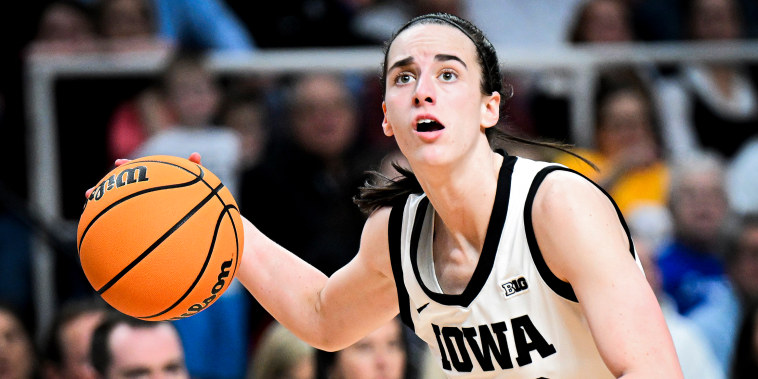The NCAA Women’s Basketball National Championship is set to smash viewership records as star players and greater TV coverage drive more fans than ever to the sport.
The matchup between Iowa and South Carolina, both No. 1 seeds, is slated for 3 p.m. Sunday at the Rocket Mortgage Fieldhouse in Cleveland.
Friday night’s matchup between Iowa and No. 3 seed UConn was the most-watched women’s college basketball game ever, and broke ESPN’s record as the most-watched basketball game in the network’s history, college or pro, with 14.2 million viewers and a peak of 17 million.
According to Richard Dietsch, a sportswriter at The Athletic, that’s more than any World Series game last year, any NBA Finals game last year, and every Daytona 500 since 2013.
On Saturday, TickPick said the ‘get-in’ price for Sunday’s women’s final was $555 — a record.
Ratings for Friday night’s women’s semifinals games, which saw Iowa beat UConn and South Carolina top N.C. State, were not available as of Saturday afternoon.
Soaring interest in the women’s game is the product of two main phenomena, experts say: a new batch of stars, including a once-in-a-generation player; and the increasing coverage those players now receive, thanks to greater investment from networks in broadcasting the games.
At the top of the star wave stands Caitlin Clark, the University of Iowa guard who has broken not only the most records for scoring in the women’s game, but earlier this year surpassed Pete Maravich as the all-time leading NCAA career basketball scorer, period. That’s a record that had stood for 54 years.
Clark has been a standout since her arrival at Iowa four years ago, leading the Hawkeyes to the Sweet 16 as a freshman while being unanimously named Big 10 Freshman of the Year and first-team All-Big Ten.
She has gone on to win the NCAA’s most valuable player award the past two years.
At the conclusion of this season, Clark, 22, will leave for the WNBA.
Yet other stars are primed to keep the momentum going for the women’s games, said Ben Portnoy, who covers college sports for Sports Business Journal. While legendary women’s coaches like Tennessee’s Pat Summitt, who died in 2016, and UConn’s Geno Auriemma have been the biggest names in the game, increased — and more consistent — media coverage has led to more players sharing in the spotlight.
In the 2021 season, ESPN and ABC switched to a national broadcast format for the women’s tournament that matched how the mens tournament was televised.
‘Broadcast, over the air coverage, had been lacking,’ said Jon Lewis, who runs Sports Media Watch, a website that tracks athletics broadcasting.
He said ESPN simply took a calculated gamble that there was finally enough demand for the women’s game that keeping it on regional broadcasts or on secondary networks like ESPN 2 was limiting opportunities for growth.
“ESPN’s a business — there’s no charity involved here,” Lewis said. “If they see the women’s Final Four is getting traction on ESPN 2, they started to wonder how many more it could get on ESPN.”
The increased coverage has coincided with a key differentiator that now separates the men’s and women’s games: professional eligibility rules — something that is allowing the women’s game to produce more stars more consistently than the men’s teams.
While women cannot go pro until they turn 22, the age limit is just 19 with one year of college for men.
“The front-line stars in men’s aren’t sticking around as much as in the women’s game,” Portnoy said. “The women’s game benefits from that.”
Among the new crop set to dominate next season’s women’s game: the University of Southern California’s Juju Watkins, Villanova’s Lucy Olsen and Notre Dame’s Hannah Hidalgo.
Portnoy said that as a result of men’s players going pro earlier, there may now be fewer household names in that sport than in women’s. And that’s reflected in some women’s games earning higher ratings this year than men’s games.
But while the men’s game may also increasingly suffer from a lack of stars, there is less structural need for them to get eyeballs, Lewis said. Instead, the lack of some traditional male-dominated powerhouses, like Duke or Kentucky, making it to the final rounds has also kept ratings growth slow this year.
The women’s game is more star-driven, Lewis said.
The end of Clark’s superstar college career could mean this year proves a high watermark for women’s tournament viewership, he said. At the same time, a new viewership floor has been set — and a lesson learned by the networks that the audiences for the women’s game are potentially huge.
‘Between the growth underway before Caitlin Clark, and the growth attributable to Caitlin Clark — I don’t see us going back to the era where it averaged fewer than 3 million viewers,’ Lewis said. ‘So there’s a new permanent higher bar for this tournament going forward.’

